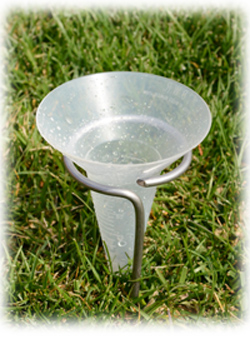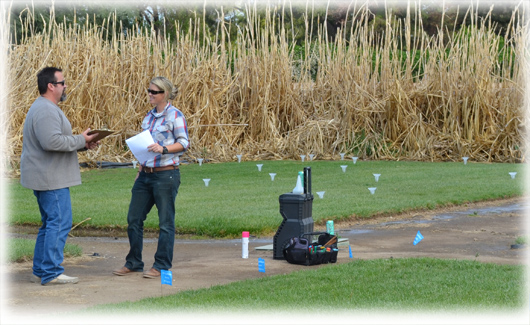California Agricultural Technology Institute
New hydrogel product aims to aid in reduction of turf water use
In the face of continuing drought conditions in California and the real possibility of urban and residential water use restrictions, several California water technology enterprises are intently focused on developing and marketing polymer products that enhance water use efficiency in grass lawns.
One of them, Aqua Cents Water Management of Fresno, is partnering with Fresno State’s Center for Irrigation Technology (CIT) to test what the company foresees as a new generation of water management using hydrogel to reduce water use in existing lawns. Aqua Cents is seeking special grant funding from the Metropolitan Water District of California to support scientific testing that would help confirm the efficacy of its product.
Hydrogels are polymer-based soil additives for water retention. Polymers are small granules that act like little sponges in the soil, absorbing water and then releasing it slowly for absorption by plant roots. They have been used widely in horticulture and agriculture with ample research on their water-saving capabilities and plant health benefits. Up until now, they have been mostly limited to new planting, transplanting and other new installations because of the way they had to be mixed into the soil.
Aqua Cents wants to change that.
“We have developed a new proprietary system that injects Aqua Cents® Hydrogel below the root zone of existing turf, with the ability to reduce outdoor water use for turf grass by 35 to 50 percent,” stated Glen Bennett, general manager for Aqua Cents and project manager for the CIT study.
 The injection system for turf utilizes the Aqua Cents Injection machine, which features
computer-controlled mechanical drivers that penetrate the soil and release the hydrogel.
The weight and tires of the machine are similar to a riding mower so it will not damage
the turf.
The injection system for turf utilizes the Aqua Cents Injection machine, which features
computer-controlled mechanical drivers that penetrate the soil and release the hydrogel.
The weight and tires of the machine are similar to a riding mower so it will not damage
the turf.
In the past three years Aqua Cents has conducted its own research in some private applications, reducing irrigation levels to 48 and 56 percent below recommended ETc levels for turfgrass, Bennett said.
“Visual inspection and photo documentation indicated that the trial turf plots, with hydrogel injection, were able to maintain comparable vitality to the control plots being irrigated at recommended ETc,” reported company CEO Tom DeLany.
At left, Aqua Cents Water Manager Jenn Downs checks water catchments used to measure sprinkler coverage during hydrogel trials.
Fresno State has utilized Aqua Cents Water Management to treat several turf areas on the university campus. Results have been positive in those applications as well. With these encouraging results, the company is now partnering with CIT to gather independent research data that will validate the capability of its product and processes, DeLany said.
Ed Norum, project engineer for CIT, is overseeing data collection for the project, which began this month. The study will include nine existing tall fescue research turf plots, each 1,800 square feet. Three control plots will undergo irrigation with no hydrogel injected. Three plots will have simply water injected in place of hydrogel. Three more plots will be injected with Aqua Cents hydrogel.
 All plots will receive traditional sprinkler irrigation, with comparative plots in
each group receiving different percentages of water application relative to ETc. This
will allow researchers to determine the quality of the grass under each irrigation
treatment and the potential for water savings under the hydrogel treatment.
All plots will receive traditional sprinkler irrigation, with comparative plots in
each group receiving different percentages of water application relative to ETc. This
will allow researchers to determine the quality of the grass under each irrigation
treatment and the potential for water savings under the hydrogel treatment.
The trials will run through October. CIT staff will monitor irrigation treatments on all nine plots, collect data regarding the quality of the turf grass, the amount of metered water used, and the water savings as a percentage below recommended ETc.
"With the understanding that water consumption for turf grass can range from 50 to 70 percent of total urban landscape water consumption, particularly in summer months, our target markets and audience will be facility managers, property owners and managers, and communities grappling with the high cost of water while seeking to maintain an outdoor environment that includes turf grass and green space where appropriate,” DeLany said.
Serious things to consider in the face of possible water restrictions in urban areas are the impacts not only on residential properties, but on municipal parks, school playgrounds, athletic fields, and cemeteries, he noted.
Test results will be available later this year. For more information about CIT research and testing services, contact Norum at edwardn@csufresno.edu.
